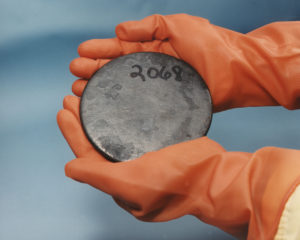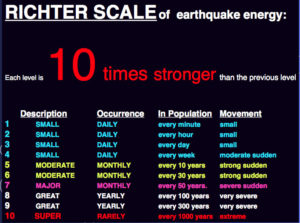Read: Applied Exponential and Logarithmic Equations
Learning Objectives
- Solve half-life problems
- Solve pH problems
- Solve problems involving Richter scale readings
- Solve problems involving decibels
In previous sections, we learned the properties and rules for both exponential and logarithmic functions. We have seen that any exponential function can be written as a logarithmic function and vice versa. We have used exponents to solve logarithmic equations and logarithms to solve exponential equations. We are now ready to combine our skills to solve equations that model real-world situations, whether the unknown is in an exponent or in the argument of a logarithm.

One such application is called half-life, which refers to the amount of time it takes for half a given quantity of radioactive material to decay. The table below lists the half-life for several of the more common radioactive substances.
| Substance | Use | Half-life |
|---|---|---|
| gallium-[latex]67[/latex] | nuclear medicine | [latex]80[/latex] hours |
| cobalt-[latex]60[/latex] | manufacturing | [latex]5.3[/latex] years |
| technetium-[latex]99[/latex]m | nuclear medicine | [latex]6[/latex] hours |
| americium-[latex]241[/latex] | construction | [latex]432[/latex] years |
| carbon-[latex]14[/latex] | archeological dating | [latex]5,715[/latex] years |
| uranium-[latex]235[/latex] | atomic power | [latex]703,800,000[/latex] years |
We can see how widely the half-lives for these substances vary. Knowing the half-life of a substance allows us to calculate the amount remaining after a specified time. We can use the formula for radioactive decay:
where
- [latex]{A}_{0}[/latex] is the amount initially present
- T is the half-life of the substance
- t is the time period over which the substance is studied
- [latex]A(t)[/latex] is the amount of the substance present after time t
Example
How long will it take for ten percent of a [latex]1000[/latex]-gram sample of uranium-[latex]235[/latex] to decay?Answer: [latex]\begin{array}{c}\text{ }y=\text{1000}e\frac{\mathrm{ln}\left(0.5\right)}{\text{703,800,000}}t\hfill & \hfill \\ \text{ }900=1000{e}^{\frac{\mathrm{ln}\left(0.5\right)}{\text{703,800,000}}t}\hfill & \text{After 10% decays, 900 grams are left}.\hfill \\ \text{ }0.9={e}^{\frac{\mathrm{ln}\left(0.5\right)}{\text{703,800,000}}t}\hfill & \text{Divide by 1000}.\hfill \\ \mathrm{ln}\left(0.9\right)=\mathrm{ln}\left({e}^{\frac{\mathrm{ln}\left(0.5\right)}{\text{703,800,000}}t}\right)\hfill & \text{Take ln of both sides}.\hfill \\ \mathrm{ln}\left(0.9\right)=\frac{\mathrm{ln}\left(0.5\right)}{\text{703,800,000}}t\hfill & \text{ln}\left({e}^{M}\right)=M\hfill \\ \text{ }\text{ }t=\text{703,800,000}\times \frac{\mathrm{ln}\left(0.9\right)}{\mathrm{ln}\left(0.5\right)}\text{years}\begin{array}{c}{cccc}& & & \end{array}\hfill & \text{Solve for }t.\hfill \\ \text{ }\text{ }t\approx \text{106,979,777 years}\hfill & \hfill \end{array}[/latex]
pH
 In chemistry, pH is used as a measure of the acidity or alkalinity of a substance. The pH scale runs from [latex]0[/latex] to [latex]14[/latex]. Substances with a pH less than [latex]7[/latex] are considered acidic, and substances with a pH greater than [latex]7[/latex] are said to be alkaline. In our next example we will find how doubling the concentration of hydrogen ions in a liquid affects pH.
In chemistry, pH is used as a measure of the acidity or alkalinity of a substance. The pH scale runs from [latex]0[/latex] to [latex]14[/latex]. Substances with a pH less than [latex]7[/latex] are considered acidic, and substances with a pH greater than [latex]7[/latex] are said to be alkaline. In our next example we will find how doubling the concentration of hydrogen ions in a liquid affects pH.
Example
In chemistry, [latex]\text{pH}=-\mathrm{log}\left[{H}^{+}\right][/latex]. If the concentration of hydrogen ions in a liquid is doubled, what is the effect on pH?Answer:
Suppose C is the original concentration of hydrogen ions, and P is the original pH of the liquid. Then [latex]P=-\mathrm{log}\left(C\right)[/latex]. If the concentration is doubled, the new concentration is [latex]2[/latex]C. Then the pH of the new liquid is
Using the product rule of logs
Since [latex]P=-\mathrm{log}\left(C\right)[/latex], the new pH is
When the concentration of hydrogen ions is doubled, the pH decreases by about 0.301.
Richter Scale
 Richter Scale of Earthquake Energy
Richter Scale of Earthquake Energy[latex]R=\mathrm{log}\left(\frac{A}{A_{0}}\right)[/latex]
The intensity of an earthquake will typically measure between [latex]2[/latex] and [latex]10[/latex] on the Richter scale. Any earthquakes registering below a [latex]5[/latex] are fairly minor; they may shake the ground a bit, but are seldom strong enough to cause much damage. Earthquakes with a Richter rating of between [latex]5[/latex] and [latex]7.9[/latex] are much more severe, and any quake above an [latex]8[/latex] is likely to cause massive damage. (The highest rating ever recorded for an earthquake is [latex]9.5[/latex] during the [latex]1960[/latex] Valdivia earthquake in Chile.)Example
An earthquake is measured with a wave amplitude [latex]392[/latex] times as great as [latex]A_{0}[/latex]. What is the magnitude of this earthquake using the Richter scale, to the nearest tenth?Answer: Use the Richter scale equation. [latex-display]R=\mathrm{log}\left(\frac{A}{A_{0}}\right)[/latex-display] Since A is [latex]392[/latex] times as large as[latex]A_{0}[/latex], [latex]A=392A_{0}[/latex]. Substitute this expression in for A. [latex-display]R=\mathrm{log}\left(\frac{392A_{0}}{A_{0}}\right)[/latex-display] Simplify the argument of the logarithm, then use a calculator to evaluate. [latex-display]\begin{array}{c}R=\mathrm{log}\left(\frac{392A_{0}}{A_{0}}\right)\\=\mathrm{log}\left(392\right)\\=2.5932\\\approx{2.6}\end{array}[/latex-display]
Answer
The earthquake registered [latex]2.6[/latex] on the Richter scale.Decibels
[latex]d=10\mathrm{log}\left(\frac{P}{P_{0}}\right)[/latex]
where P is the power or intensity of the sound and P[latex]0[/latex] is the weakest sound that the human ear can hear. In the next example we will find how much more intense the noise from a dishwasher is than the noise from a hot water pump.Example
One hot water pump has a noise rating of [latex]50[/latex] decibels. One dishwasher, however, has a noise rating of [latex]62[/latex] decibels. The dishwasher noise is how many times more intense than the hot water pump noise?Answer: You can’t easily compare the two noises using the formula, but you can compare them to [latex]P_{0}[/latex]. Start by finding the intensity of noise for the hot water pump. Use h for the intensity of the hot water pump’s noise.
[latex]50=10\mathrm{log}\left(\frac{h}{P_{0}}\right)[/latex]
Divide the equations by [latex]10[/latex] to get the log by itself.[latex]5=\mathrm{log}\left(\frac{h}{P_{0}}\right)[/latex]
Rewrite the equation as an exponential equation.[latex]10^5=\frac{h}{P_{0}}[/latex]
Solve for h, the intensity of the water pump.
[latex]h=P_{0}10^5[/latex]
Repeat the same process to find the intensity of the noise for the dishwasher, use d to represent the intensity of the sound of the dishwasher. Remember that [latex]{P_{0}}[/latex] is a baseline for the most faint sound the human ear can hear.[latex]\begin{array}{c}62=10\mathrm{log}\left(\frac{d}{P_{0}}\right)\\6.2=\mathrm{log}\left(\frac{d}{P_{0}}\right)\\10^{6.2}=\frac{d}{P_{0}}\\d=P_{0}10^{6.2}\end{array}[/latex]
To compare d to h, you can divide. (Think: if the dishwasher’s noise is twice as intense as the pump’s, then d should be [latex]2[/latex]h—that is, [latex]\frac{d}{h}[/latex] should be [latex]2[/latex].) Use the laws of exponents to simplify the quotient.[latex]\Large\frac{d}{h}=\frac{P_{0}10^{6.2}}{P_{0}10^5}=\frac{10^{6.2}}{10^{5}}=\normalsize10^{6.2-5}=10^{1.2}[/latex]
Answer
The dishwasher’s noise is [latex]10^{1.2}[/latex] (or about [latex]15.85[/latex]) times as intense as the hot water pump.Licenses & Attributions
CC licensed content, Shared previously
- Precalculus. Provided by: OpenStax Authored by: Jay Abramson, et al.. Located at: https://openstax.org/books/precalculus/pages/1-introduction-to-functions. License: CC BY: Attribution. License terms: Download For Free at : http://cnx.org/contents/[email protected]..
- HEUraniumC. Authored by: http://web.archive.org/web/20050829231403/. License: Public Domain: No Known Copyright.
- Lemon. Authored by: Andru00e9 Karwath. Located at: https://commons.wikimedia.org/w/index.php?curid=59992. License: CC BY-SA: Attribution-ShareAlike.
- Earthquake_Richter_Scale. Authored by: Webber. Located at: https://commons.wikimedia.org/w/index.php?curid=1567023. License: Public Domain: No Known Copyright.

Analysis of the Solution
Ten percent of [latex]1000[/latex] grams is [latex]100[/latex] grams. If [latex]100[/latex] grams decay, the amount of uranium-[latex]235[/latex] remaining is [latex]900[/latex] grams.